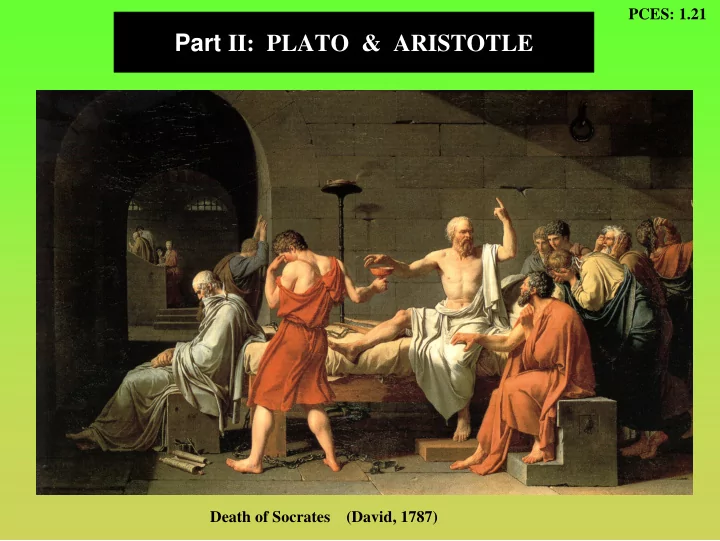

PCES: 1.21 Part II: PLATO & ARISTOTLE Death of Socrates (David, 1787)
PCES: 1.22 Plato: the Quest after Ultimate Truth Plato was heavily influenced by Socrates when young, and also by the death of Socrates. Socrates was condemned byan Athenian court to die (and did so by voluntarily drinkinghemlock, refusing an offer to escape made by friends). The charge was corrupting the young (which he had done by philosophizing, in a way described in Plato’s dialogues). This has immortalized the “Socratic method”, which tries to elucidate a problem, or the truth of an idea, by dialectic Socrates (question and answer) inquiry. (470-399 BC) "Who then a "W ho then are lovers e lovers of of wisd wisdom (philo om (philosophers)? sophers)? Those who seek to discern the Those who seek to d scern the ultim ultimate na ate nature of reality." ture of reality." Plato, Plato, The Commonw The Commonwealth ealth The writings of Plato (which we apparently have in their entirety) are very wide-ranging. We are here concerned with those parts relevant to the physical world and our knowledge of it. We will concentrate on the “Theory of Forms” and its implications. This theory is introduced on the next slide, and discussed extensively in the Course Notes. Apart from Socrates, Plato was heavily influenced in the formulation of his ideas by (i) the ideas of Heraclitus & Parmenides on change vs. constancy, and (ii) the developments in mathematics (notably by his friend Thaetetus, and by the earlier Pythagorean school). This led to an interest in geometry, including solid geometric figures – although it is not clear how much Plato himself was involved in the study of these. Plato (428-348 BC)
PCES: 1.23 PLATO: the THEORY of “FORMS” PLATO: the THEORY of “FORMS” The key idea in the “Theo The key idea in the “Theory o y of F f Forms” s” was was existence of a supra- existence of a supra-sensible realm of sensible realm of “ideas” “ideas” or “Forms r “Forms”, beyond the world of ”, beyond the world of appearances. The argument for this was appearances. The argument for this was essentially one of abstraction from particular essentially one of abstraction from particular imperfe imper fect instan ct instances o ces of th things in ings in the sensible the sensible world (eg., objects that were approximately world (eg., objects that were approximately circular cir cular), to the ‘real’ ), to the ‘real’ things, the universal things, the universal ‘F ‘Forms’, like ‘Circle’, which could only be orms’, like ‘Circle’, which could only be defined in the higher world of Forms. defined in the higher world of Forms. From ideas about simple Forms like “Circle’, From ideas about simple Forms like “Circle’, Plato went on to discuss higher forms, Plato went on to discuss higher forms, culminating in the high culminating in the highest of all: the “Good”. est of all: the “Good”. Plato’s Cave allegory likens our sense perceptions to the shadows of real objects cast upon the wall of a cave. The real objects, in this allegory, represent the higher “Forms” of which we have no direct perception. True knowledge is then knowleDge of the archetypal forms themselves, which are real, eternal, & unchanging. Sense perception, then, does not give us access to reality, but only to an impermanent world of perception. In modern physics, the ultimate constituents of matter resemble Platonic Forms: one deals with Fields and Probability amplitudes, as we will see. The irony is that the existence of these very abstract entities has been discovered by us, not by philosophical speculation or ratiocination, but instead by a combination of mathematical theory and experiment: ie., by a combination of the kind of mathematical deduction that Plato envisaged, together with the kind of experimentation that he apparently would have ruled to be irrelevant.
PCES: 1.24 Aristotle: the Real World Aristotle was the most illustrious student of Plato; he wasa pupil in his school “the Academy” and later founded his own (the “Lyceum”). He himself was a teacher to the youngAlexander the Great- who later conquered & changed the whole of the known world as far as India, Vastly extending the influence of Greek ideas & culture (perhapsin line with Plato’s ideas on the role of education!). Theinfluence of Aristotle on later European culture was colossal. Aristotle (384-322 BC) Aristotle classified and organized the whole of Greek thinking, in a way so comprehensive and detailed, & with such perception, that modern education is still designed along the lines he laid out. We only have later versions of his writings, the originals being lost (in, eg., the fire in Alexandria). For us the principal interest of Aristotle is in his denial of Plato’s supra- sensible world- he argues instead for a single physical world. The fundamental “stuff” of this, which he called “substance”. Any object in the world was described in terms of 4 ‘Causes’: Material Cause: the matter from which it is made Formal Cause: the form the matter takes Efficient Cause: the influences/agencies acting to change the object Final Cause: the purpose or goal of the object and of the changes Only one of these (the efficient cause) conforms to the modern use of the term ‘cause’. For Aristotle, it was impossible to separate any of these causes from the others – it was meaningless to talk about ‘form’ or ‘Forms” separately from the rest. The fundamental nature, including the very existence of an object, resulted from its 4 Causes. Aristotle & Alexander
Recommend
More recommend